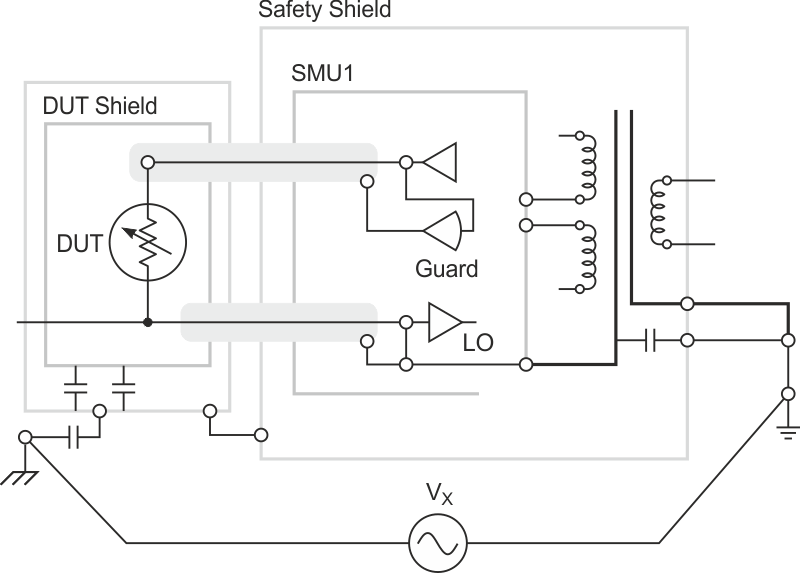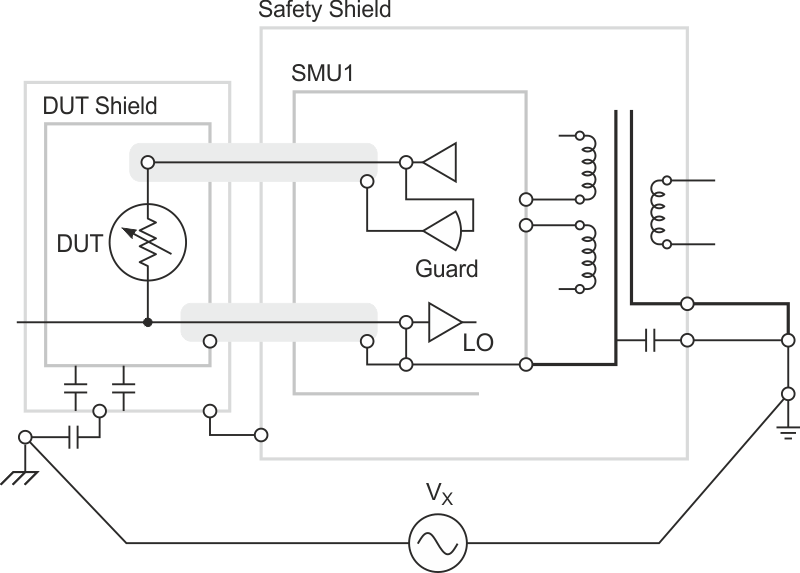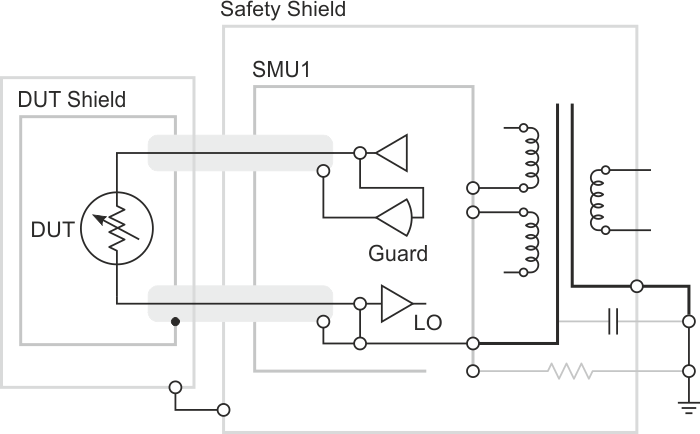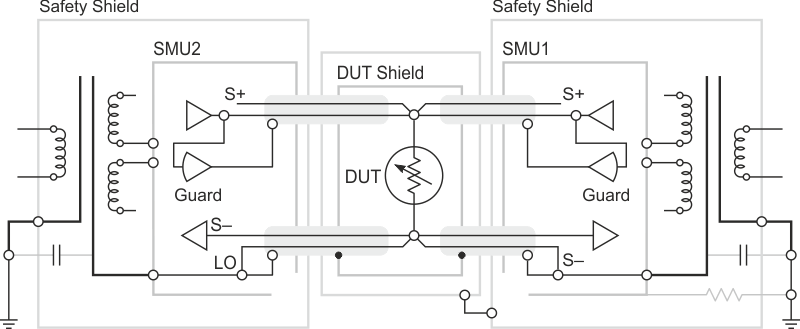The safety shield surrounds the electrostatic shield, protecting the instrument user from hazardous voltages on the DUT, or the measurement leads. The safety shield should be connected to earth ground at the instrument, and it should have a current capacity greater than the larger of the SMU output current and any earth-referenced source driving the LO terminal. When this safety shield is in place, if a measurement lead, the electrostatic shield, or the driven guard were to touch the inside of the safety shield, the earth connection would keep the safety shield at a low potential. The safety shield also provides protection from the AC mains inside the instrument. In this case, the safety shield is the instrument chassis, which is also connected to earth. The safety grounding system follows the power system to allow this connection to be made. Instrumentation is safety grounded at the power inlet, ensuring that the metal instrument enclosure is always safe to touch. Even if a line voltage connection were to come loose and contact the enclosure from the inside of the instrument, the safety ground would keep the instrument chassis at a low potential and safe to touch.
The safety ground shield should never be used as the electrostatic shield. Even well-designed instrumentation generates currents that travel down the safety ground in the line cord. Current from the power supply Y capacitors and higher frequency currents from a switching power supply can generate noise voltages on the instrument chassis with respect to external safety ground as the current flows through the inductance of the power cord. The resulting noise voltage appears as a common mode voltage from the safety ground to the instrument chassis. This voltage is troublesome because instrumentation measurement common is not completely isolated from the instrument chassis (earth grounded). Every instrument generates some DC and AC leakage current across the instrument mains isolation barrier, and a finite capacitance from instrument common to the instrument safety ground. This capacitance is what facilitates the flow of AC current. We do not want these currents to flow through any part of the measurement pathway (see Figure 4). These currents create voltage drops in the measurement leads, as well as voltages across other impedances in the measurement circuit.
 |
||
| Figure 4. | An illustration of the power system components that generate common mode current, as well as the isolation capacitances that support AC currents generated externally. |
|
Because instruments may be designed to float hundreds of volts above earth ground, and shield ground should be connected to the instrument measurement common, the measurement terminals and electrostatic shield should always be considered unsafe.
Grounding the shield
Should the instrument shield (which is instrument LO) be connected to safety ground? Only if the application does not drive LO, and it should be done in a way that does not allow currents to flow in the measurement leads. From an instrumentation perspective, the only reason to connect LO to safety ground is to keep the measurement terminals within the common mode specification of the instrument. Given that the measurement LO terminal is floating in many instrument designs, a higher value (~100K ohms) resistor can be added from safety ground to the measurement LO terminal.
Common Mode Current
In the section titled “Safety Grounding,” I mentioned that the instrument(s) themselves are responsible for some of the current that generates the common mode voltage, VX (see Figure 4). These common mode currents are a direct result of the magnitude of the voltages on the primary and secondary windings of the power transformer acting on the unshielded capacitance across the transformer.
Figure 4 illustrates a typical instrument power transformer designed with primary and secondary shields. The shields within a power transformer perform the same function as the instrument shields already discussed. In the case of the instrument shield, when a portion of the measurement remains unshielded, external field lines can inject current into the measurement. The same is true with the power transformer, except due to the proximity of the primary to the secondary windings, as well as the magnitude of the voltages, the currents could be much higher if the transformer shields were absent. The capacitor C1 represents the unshielded capacitance from the secondary winding to the primary shield. This is the portion of the primary that remained unshielded. Likewise, the capacitor C2 represents the unshielded capacitance from the primary winding to the secondary shield. The total common mode current is the sum of the currents through each of these capacitors. The common mode current will increase as the primary and secondary transformer voltages increase or when the frequency of the power supply operation increases. The unshielded capacitance offers increasingly lower impedance to higher frequency edges, increasing the magnitude of the common-mode current.
Common-mode current originating on the primary flows through the capacitor C2 into the secondary circuits, into the chassis through the measurement leads, and eventually returns to the primary ground that generated it. Common-mode current originating on the secondary flows through the capacitor C1 into the primary circuit, into the chassis at the power-entry module, then through the measurement leads, and eventually returns to the secondary ground that generated it. The net common-mode current causes a voltage drop in the instrument power cord inductance, as well as a voltage drop in the ground connection between the DUT and the instrument. For this reason, it is best to use the chassis connection provided by the instrumentation whenever possible to avoid introducing a new safety ground to the system. The unshielded capacitance and, to a lesser degree, the DC resistance across the transformer can couple noise currents from other sources that generate differences in safety grounds throughout the building.
Example of a well-shielded and grounded single SMU test system
In the example shown in Figure 5a, if the measurement LO terminal were to be grounded to earth at the DUT LO terminal, either directly or through a capacitance, ground currents would flow in the measurement leads, and remote sensing would have to be used to eliminate the error voltage generated by the E‑field between the two safety grounds. In Figure 5b, if the shield surrounding the DUT were connected to earth, current would not flow through the measurement LO connection. In this case, the capacitance from the DUT to its surrounding shield should be minimized. In Figure 5c, the shield is connected to earth at the instrument through a current limiting resistor. In this case, the potential between safety earth grounds depicted by VX does not force any current because only one safety earth ground has been introduced.
 |
||
| Figure 5a. | With a single SMU, grounding the DUT, either directly or through a capacitance, can channel ground current into the measurement LO lead. |
|
 |
||
| Figure 5b. | In this single SMU application, grounding LO at the DUT, either directly or through a capacitance, leads to no error currents in the measurement LO lead. |
|
 |
||
| Figure 5c. | With a single SMU, grounding the shield with a resistor, at the instrument leads to no error current in the measurement LO lead . |
|
In all of these examples, the guard should be brought as close to the DUT as possible and dropped only after it is within the DUT shield.
Example of a well-shielded and grounded multi-instrument test system
Figure 5d introduces a second instrument into the test system. In this case, preventing all ground currents from entering into the measurement is difficult because there are two different safety ground connections. So, the resulting current can be reduced by connecting LO to safety earth with a high resistance at only a single point, by connecting both shields to the DUT shield, as shown in Figure 5d. In this case, the bulk of the current will flow through both power transformers and through the shield system. Some current will flow through the measurement leads, so remote sensing will also be necessary.
 |
||
| Figure 5d | With two SMUs, the remote sense lines compensate for the current flowing in the measurement leads generated from the use of two different grounds. |
|
Conclusions
Most measurement errors can be traced to currents coupled into the DUT or into the measurement leads from external electrostatic (high-impedance) fields. Adding an electrostatic shield properly grounded to the instrument LO can totally eliminate these noise sources. In some instances, a guard must be used instead of or in addition to an electrostatic shield, for very low current applications. Differences in the safety ground caused by safety-ground currents generated from line-operated equipment can also cause measurement errors if the current is allowed to flow through the measurement leads. Common-mode current from the test system’s instruments contribute to these errors. The instrument power transformer supports this current, so any connection to safety ground should be created as described. The safety shield used to maintain operator safety offers the added benefit of providing some low-frequency RF shielding. If the instrument common is connected to safety ground with a relatively large resistor, the RF energy will not enter the instrument, and voltages due to EMI rectification can be minimized.